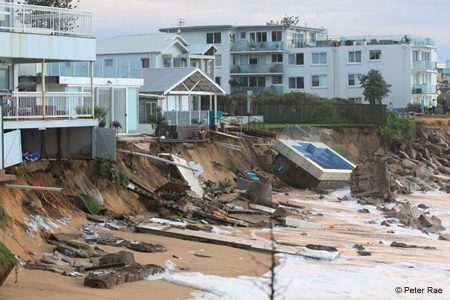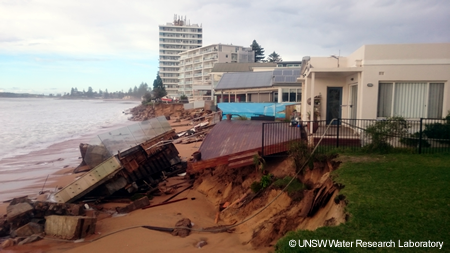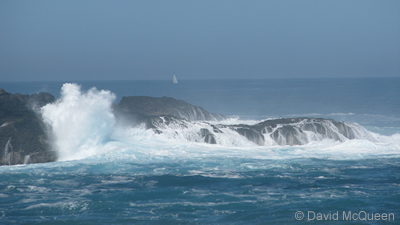
Variations in coastal sea level affects many users. Abnormally high tides can cause disruption to port, shipping and boating operations, inundate low-lying areas leading to road closures and potentially cause damage to coastal infrastructure and beach erosion especially when associated with high waves. The warning for abnormally high tides forms part of the Bureau's severe weather warning service. However, the service is limited in scope to still water level and the training therefore excludes specific discussion related to beach erosion and quantifiable inundation.
This module builds on the "Introduction to Storm Surge" module that is a recommended prior to attempting this. That module discussed the components of the total sea level: the standard or harmonic (astronomical) tides, ocean and bathymetric effects and atmospherically (wind and pressure) forced surge component. The focus here is on synoptic-weather driven storm surge as a forecastable phenomenon for the warning service.
This module supports the introduction of new guidance the National Storm Surge system. It also includes reference information for the ongoing 7-day guidance: the Total (Aggregate) Sea Level Alert system. A key feature is guidance on how to effectively use both systems during operations. As of July 2017, there are regional variations in the thresholds for adding the risk of abnormally high tides which will be described and will be updated should the service and thresholds change in the future.
Tropical cyclone storm surge is addressed in a separate module.
Allow approximately 1-2 hours to complete this module. A quiz will assess your understanding of the guidance and its application to operations. Successful completion of this course requires completing the quiz and the feedback at the end of the module.
| Method: |
Online |
| Duration: | 1-2 hours |
| Assessment: | Quiz. You'll need to achieve at least 80% on each quiz to pass overall |
| Help: | Contact Joe Courtney (08 9263 2229) David McQueen (03 9669 4793) |
- Teacher: Joe Courtney
- Teacher: Sean Fitzgerald
- Teacher: Tristan Oakley

Coastal sea level is fundamental to many activities and occasionally contributes profoundly to high-impact weather. Variations in coastal sea level occur at many timescales and are attributed to distinct physical factors; including astronomical tides, marine meteorology and ocean dynamics. The sea level observed at any location is strongly modulated by the surrounding bathymetry. Surface wave and barotropic adjustment phenomena are prominent.
In this module, we focus on synoptic-weather driven storm surge as a forecastable phenomenon associated with significant deviations from 'normal' harmonic tides. The emphasis on abnormally high tides reflects the major impacts storm surges have on land-based infrastructure and activities and aligns with the warning service provided by the Bureau. The warning service for abnormally high tides is limited in scope to still water level and the training, therefore, excludes discussion related to impacts such as coastal erosion and inundation.
Tropical cyclone storm surge is addressed in a separate module.
Allow approximately 1-2 hours to complete this module. There is one quiz at the end of the module to assess your understanding of the theory. A grade of at least 80% is required in this quiz to pass the course.
| Method: |
Online |
| Duration: | 1-2 hours |
| Assessment: | One theory quiz requiring at least 80% to pass overall |
| Help: | Contact David McQueen (03 9669 4793) |
- Teacher: Sean Fitzgerald
- Teacher: David McQueen

| Method: |
Online |
| Duration: | 1-2 hours |
| Assessment: | Quiz. You'll need to achieve at least 90% on the quiz to pass overall |
| Help: | Contact James Thompson or David McQueen (03 9669 4793) |
- Teacher: Sean Fitzgerald
- Teacher: Tristan Oakley
